Tuesday, May 22nd, 2018

Marge Carson Living Room Ionia Cocktail Table IN02
Also known as Classicism, classic interior design first came into existence during the 17th-19th centuries. It manifested in many different aspects including music, art, literature, and architecture.
If you want to use a classic style in your home, then you’d have to know how to go about with noble decoration, geometric shapes, and utilitarian frills if any.
History of Classicism
Classicism is believed to have originated in France during the 17th century. It then quickly spread through Europe and became the dominant design for a span of two centuries. The artists then were so inspired by the Greek and Roman art which both showed clarity, rigor, yet at the same time, a different kind of simplicity.
Classicism has strict rules but it still managed to influence other nations throughout the globe. When the style found its way to England, it became a representation of rationalism as well as precision. When Catherine the Great ruled, Classicism began to conquer even the land of Russia. The style then was still dignified, full of harmony but also practiced reasonable restraint.
In Russia, architectural structures such as the one in Petersburg showed the exact taste of the nobles of the Russian empire.
Russian Classicism was a trend of its own with its unique architecture during the 18th and 19th centuries proving to the world just how different their style was. This movement allowed the birth of eclecticism, too, which mixed different classic styles during that time.
Photos of classical interiors show the extreme orderliness, respectability, solidity, and predictability of this style. This design just proves that it is totally independent of other fashion trends.
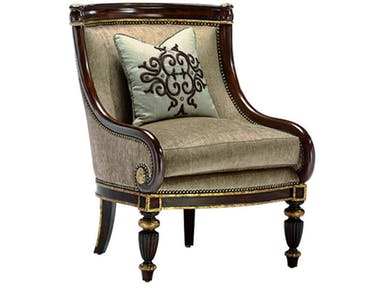
The subdued elegance of the Marge Carson Living Room Ionia Lounge Chair ION41 is what makes it the perfect living room piece for a classic home.
Classic Style Is Subdued
Classic houses are attractive because of their subdued color palette and their royal dignity. Light pastels are commonly seen. You won’t see any bright hues as the shades are all neutral and calm. The overall classical interior actually even has a soothing effect.
Colors that are permitted include cream, olive, beige, shades of gold, and light green. These are fairly common in the furniture, finishing materials, and textiles. Shades of brown (especially the natural and warm wood color) are highly permissible. When using wood tones, though, make sure that you don’t make the room look gloomy. For the textiles and upholstery, use sand, blue-green, and blue hues.
You will recognize classic interior design also when you find discreet columns, cornices, and clear-outlined doors and windows. You will also typically find marble fireplaces with the paired furnishings in rectangular form. The presence of stucco, arches, columns and full columns is also apparent.
The rooms come with niches that are decorated with ancient statues. Talk of Greek gods such as Athena or Zeus himself. The ornaments are just as classical, one can typically find laurel or oak leaves.
These days, classic homes are often owned by the wealthiest people who are confident with their style preference. They are also people who prefer the age-old look that no other style can offer. They are the ones who want the type of style that lingers.
Classic homes also do not sport anything cheap. All the materials that are used are unique and natural and, therefore, pricey. Pilasters are made of marble as are the columns. The stucco is handmade which is totally different from the classic imitations that are practically seen everywhere.
The classical ceiling is often white and decorated with stucco friezes.
As for the classic lighting, you should illuminate the rooms with no less than crystal chandeliers. Be sure to install these strictly at the center of the ceiling. This is so the light is evenly distributed throughout the room.
Display lamps that are made of expensive glass or transparent stones.
Tags: classic interior design, classic interiors, classic style, classicism, McCreerys, McCreerys Home Furnishings
Posted in Interior Design 101, Interior Design Elements, Interior Design Themes | Comments Off on The Classic Interiors: Elegance at Its Best
Friday, February 3rd, 2017
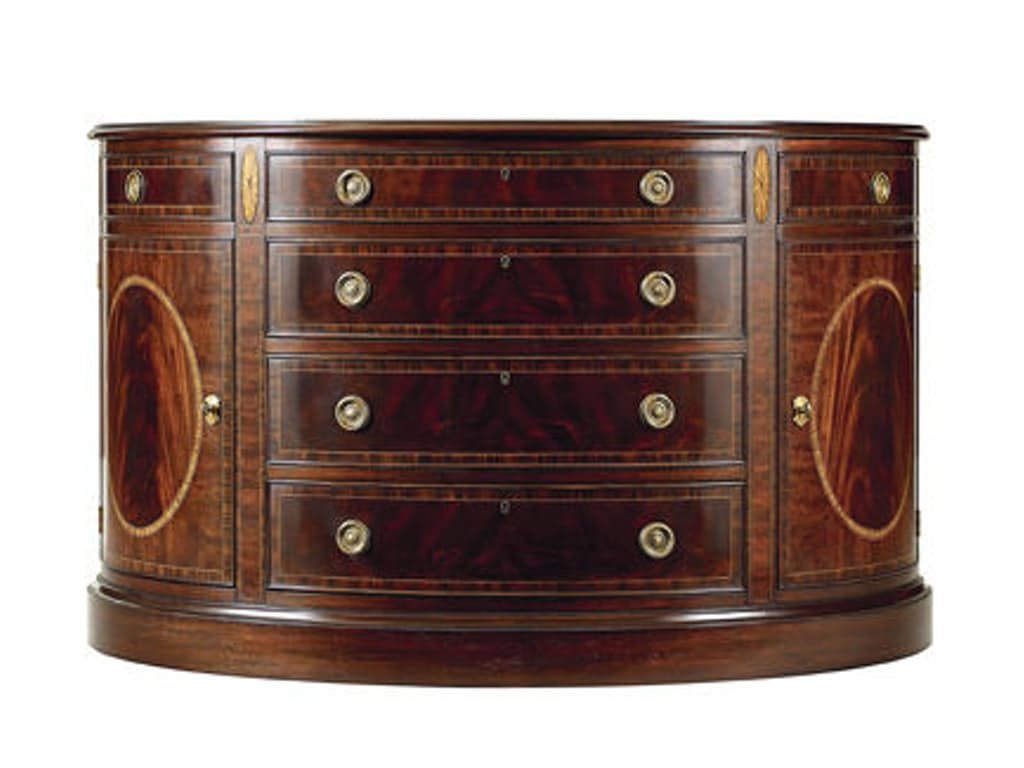
Henredon Living Room Buffet 9401-21
Classicism is a kind of design that’s evident in European art during the 17th to the 18th centuries. This is reflected in architecture, art, literature and music. Also simply called as the classic style, it has been utilized as a style for nobles’ homes.
Classic homes are attractive because of their tranquil colors. They also evoke a high sense of dignity. These days, classic homes are being picked by the well-to-do. They are the ones who have a settled preference as well as an appreciation for longstanding cultural values. They are the ones who know what’s enduring and why it will always win against fleeting fashion.
Classicism and Its History
Classicism began in France during the 17th century. This soon spread to the rest of Europe and became a leading style for two centuries. The artists of those centuries were largely inspired by the arts of Rome and Greece. These evoked rigor, simplicity and clarity.
Despite having strict rules, classic style was embraced by many other nations. It was France, though, that showed the full luster and splendor of this design. When compared to English classicism which is more rigorous and rational, the French version was more straightforward.
It was during the reign of Catherine the Great that a reasonable restraint was placed on Classicism. This was shown when classic style invaded Russia. Petersburg and other such buildings are the living proofs of this enduring design. Other noble estates throughout the Russian Empire also reflected this design.
Russian classicism brought about a brand new trend during the 18th to the 19th centuries. This design now allowed the fusion of classics with other designs.
Mimicking Classicism
So now you’ve realized the beauty of classicism. It is not too difficult to set up in your home. You just need to recognize the features that will make your interiors more classic.
First, be wary of your home’s architecture. Your place must have discreet columns, cornices, windows and doors. These must also have clear outlines. Marble fireplaces are welcome. Creating a rectangular form for these elements will surely pay off.
Next, don’t go gaga over your color palette. Use light pastels for your color scheme.
Classical ornaments include laurel or oak leaves and Greek meander. These must be arranged at a certain order as well as symmetry. Make sure that the stuccos, arches, columns and half-columns are emphasized.
One good interior design practice is to be orderly in all things. The design elements must also be respectable and predictable. They must show a level of solidarity that’s difficult to match.
This may not be your cheapest choice when it comes to interior design but you and your family will surely love the outcome. Know that your home will be forever independent from the trends that most homes default to.
Nothing’s Cheap
Classicism will never embrace cheap finish. Every material used must be unique or at least natural, therefore, its price tag is steep. Plasters and columns are often made of marble while stuccos are handmade.
Walls are covered with panels of natural wood or cloth. Used parquet is a common flooring material though kitchens, bathrooms and living room could have stone or marble tiles.
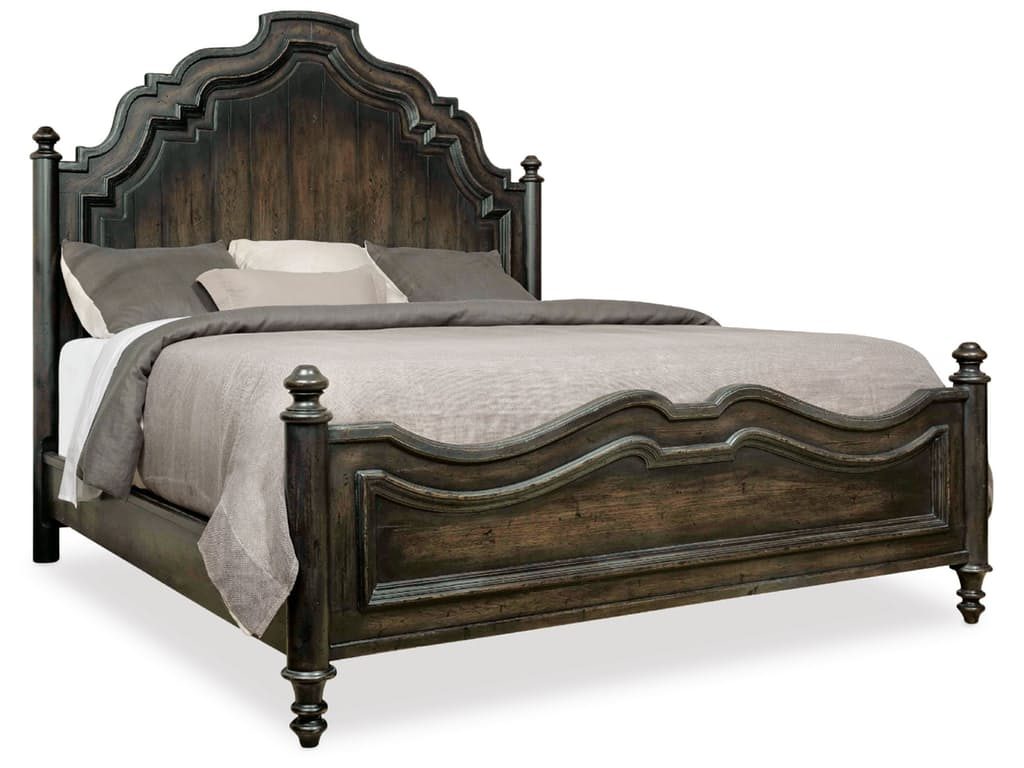
Hooker Furniture Bedroom Auberose King Panel Bed
Classic Colors
Colors and contrasts in classicism do not show bright hues. The shades are neutral and calm. Often used are beige, olive green, cream, gold and light green. These are reflected on furnishings and textiles. It is also okay to use different shades of brown (which is why wood is a welcome element).
Don’t forget, though, that the room must not look dark or gloomy. Textiles and upholstery must use blue green, blue or sandy colors.
Tags: classic home, classic interior design, classic interiors, classicism, McCreerys, McCreerys Home Furnishings
Posted in Interior Design 101, Interior Design Themes | Comments Off on Classicism: Why Old Is Still In
Wednesday, February 24th, 2016
Owning a Victorian home is not everyone’s privilege. To others, this is just a dream; to you, however, it may not be as dreamy especially when you discover that as ancient as the design are the roofing, wirings and windows. ‘Thinking of remodelling your Victorian home?
Most of the time, remodelling projects is not simple. Revamping an old home can be time consuming. Before you jump into modernizing your beautiful historical home, you may want to speak to some of the preservation societies first.
Owning a Victorian dwelling is intriguing and a lifelong journey for some. Such a home is full of character and works of craftsmen that – even when it’s already old – it can still catch home buyers’ attention.
Victorian Characteristics
Victorian homes were built somewhere between 1837 till 1901. This was the era when Queen Victoria still ruled. There are some people, however, who have also typified Victorian architecture to be Edwardian as well. This is what takes the period all the way to 1910.
Figure 1FFDM’s Vintage Classics
Edwardian and Victorian housing dominate the British suburbs today, for instance, the City Centre Conservation Areas and the Peterborough’s Park. Edwardian homes are seen to be less in value when compared to Victorian though most of their features tend to be similar.
The traits that separate Victorian homes from the rest are –
Terraces. As more and more country people went to the urban areas, Victorian homes were then built in terraces where the kitchen is at the back while the garden is both at the front and rear. There are no garages since Victorian homes were built during those times when there were still no cars. These days, the gardens are often removed in favor of the parking slot.
Patterned bricks. The advent of the railway brought about easier transport for bricks and other such materials. It is because of this that patterned brick became quite popular. The Flemish Brick bond is often used in many Victorian houses. This is characterized by alternating headers or bricks whose ends appear on the face of the house’s wall. Stretchers, on the other hand, are the long sides of bricks appearing on the face of the wall.
Barge boards. These are the decorative wooden panels that are found on the gable ends of buildings. This is that triangular portion of the pitched roof. Look for these sections because they point directly to the Victorian period when such decorative panels were popular.
Bay and sash window. It was in 1832 when the plate glass arrived. This resulted into larger windows with six or four panes and a vertical sliding sash window, a single glazing bar right down the middle.
It was also fashionable to have a three-sided bay window. A ground floor bay window usually had a roof of its own.
Decorated roof line. Slate roofs are quite common among Victorian houses. Thanks to the wonders of the railway, the trains were able to haul slate and deliver at longer distances. Finials are often seen on the ridge and gable ends. Roofs also have ridge tiles that are made of terracotta. Whether it is glazed fired clay or unglazed, the color used is often red.
Stained glass. One of the most exciting design materials is stained glass. It originated from the Gothic revival and was popular during the Victorian period. Mosaic stained glass even replaced painting in many homes. These are often found on top of windows or on doors.
Floor tiles. Most Victorian homes come with geometric terracotta tiles especially on the porch areas. The ground floor is also often made with these materials. These tiles come in natural colors such as brown and red, dark blue, off-white and black.
A fireplace. What is a Victorian home without this? This is used to keep the house warm and is often surrounded by marble, stone or wood. Terracotta chimney pots are also quite common.
Tags: British, classic, classic design, classic home, classic interior design, classic interiors, classic style, classicism, Edwardian, McCreerys, McCreerys Home Furnishings, Victorian, Victorian fashion, Victorian furnishings, Victorian home, Victorian interior design, Victorian interiors, Victorian style
Posted in Interior Design 101, Interior Design Themes | No Comments »
Thursday, February 11th, 2016
Have you been searching for the look that would be most suitable for your home? If you want a look that is just right, one that is not too formal, fussy, warm or comfortable; one that is not traditional or contemporary, then what you want is the transitional look. Transitional interior design is streamlined spaces that harmonize all the design elements.
Transitional interior design works because it is what’s featured in many interior design magazines. Take a closer look at those photos and you will notice how you will get the best of both worlds – the old and the new.
Transitional interiors do not stray from what you have been familiar with. You actually have the leeway to freshen the look of your home according to your tastes. You can also update indefinitely if you want to reflect the interior design trends. As seasons pass, the design will also age, eventually, you will start to enjoy the timelessness that your home offers.
Transitional interior design is all about achieving the balance between traditional and contemporary. Sometimes, this is not the case. You can also mix and match a few pieces coming from other interior design themes. This is as long as they do not detract from the tailored setup.
Transitional Is Updated Classic
Also known as updated classic, you are sure to love this theme if you are a diplomat. You can use some statement accessories as the transitional look is one that suits color junkies.
Warm neutrals are the ruling hues for this style so go ahead and use taupe, cream, khaki, tan or gray. A hint of espresso or chocolate is also welcome. There should be an understatement of patterns. Do not use huge florals and bold prints.
If you are one person who cannot imagine a world without bright colors, then make sure that you use these hues strategically. Accents can have bright colors as can lamps, artworks and throw pillows.
Monochrome is never boring when used in a transitional setting. When used, though, make sure that you invest in strong furniture, patterned curtains, and wooden pieces. These are pieces that can effectively break up the neutrality of your chosen color palette.
Wide windows can offer ample lighting. Find lighting fixtures that can highlight special upholstery, walls and rugs. Transitional furnishings come with straightforward designs and crisp profiles. Say no to baroque finish, instead, find gentle curves that offer subtle energy.
Updated versions of furniture can be used together with the older sets. Use scales that are big enough. Make sure the cushions are inviting and comfortable. You would want your guests to relax and just flop down once you invite them over.
Clean lines are your new best friend when trying to embrace the transitional look. Shapely armchairs can balance a simple sofa. Round ottoman or a round table can be the perfect circular motif in a living room.
Transitional Flooring
Flooring is a crucial backdrop in all transitional rooms. Forget about the materials and concentrate more on the colors. You can use stone, natural wood, tile, or carpeting. You have the freedom to mix different floor surfaces in your home.
Since color cannot be relied upon in punching up the flooring or even the rest of your transitional space, the be sure to take note of the textures that you bring in. Use natural fibers, woven fabrics, shiny and matte finishes. Think also of chenille, burlap, sisal, leather and rattan. These are materials with tactile beauty which will fit just right in. Do not go overboard, though. Layer these materials effectively and you will see your home come to life.
Tags: classic, classic design, classic interior design, classic interiors, McCreerys, McCreerys Home Furnishings, transitional, transitional interior design, transitional interiors
Posted in Interior Design 101, Interior Design Themes | No Comments »
Monday, February 1st, 2016
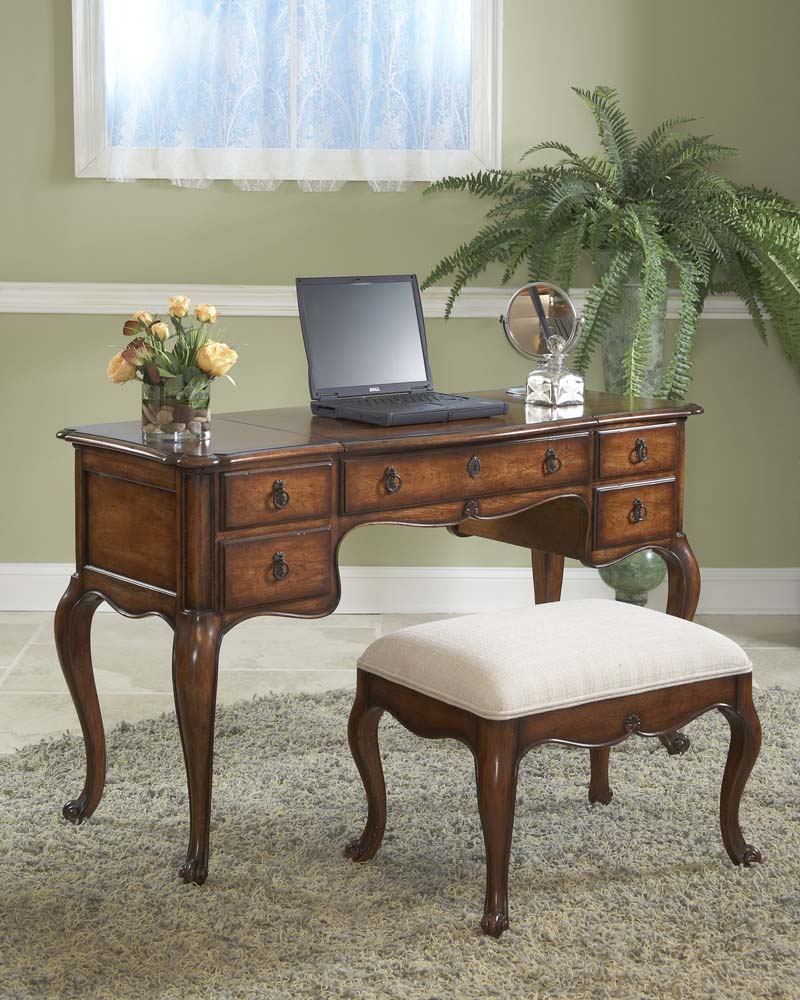
This lovely Hooker Furniture Living Room Melange Gianna Chest 638-50066 fuses the Old World and the New in a seamless manner.
The Tudor monarchs, according to history, were able to bring comparative peace and prosperity throughout England, Ireland and Wales. The wealth of many landowners was invested in buildings. Theirs was a moment of cultural bursts and classical architecture revival for Italian style. The Tudor style is a class of its own.
Europeans had a moment when gothic was at the center of their style. The perpendicular style has broken away from all this. The Tudors were the ones who developed fan vaulting (evident in the Gloucester Cathedral cloisters).
Now let’s go to a dating feature known as the Tudor Rose. This is a red rose badge with a white rose badge within. This signified the union of Henry VII to Edward IV’s daughter. This is now a decorative piece that is used to signify posh and sophistication to the highest levels.
Renaissance features can also be seen inside Tudor dwellings. These features are confined to the wealthy and the elite members of society then. Henry enthusiastically built Italianate motifs.
Then came Elizabethan homes where old homes were torn down only to be built anew. Most homeowners were then yearning for improvement as that was the great period of building. If you have ever seen those narrow yet all townhouses complete with borough walls, then these are the homes of artisans and merchants who built their homes slowly through the years.
Homes of the wealthiest members of the society are often built with huge windows and decorative chimneys. Glass was then used in Elizabethan homes with glittering glazing designs. The most elaborate fireplaces are set up and ceilings were slowly decorated with strapwork.
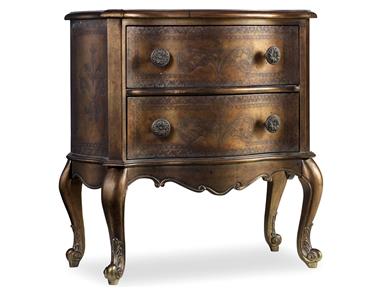
Hooker Furniture Living Room Melange Gianna Chest 638-50066 comes with a feminine pair of cabriole legs but with a masculine Old World design.
Tudor Is Symmetry
Symmetrical plans will always be favored in Tudor settings. Otherwise, Renaissance in classical details appears so then you can find fireplace, doors, and columns. Round-headed arches and niches together with all the other features of Tudor style were revived during the Victorian period.
Tudor may be an old fashioned style but it can become a part of modern living, too. The styles come originally from the UK during the 15th to the 16th centuries and are now a huge part of tourist attractions.
Genuine Tudor design can now be recreated but your place doesn’t have to look like a tourist spot, though. Only a few are lucky to live inside a genuine Tudor dwelling so for the rest of the world, repros are the answers.
Mock Tudor generally refers to black and white semi timbering on the facade of buildings. Interior design, however, is much more distinct. If you are careful enough in making your design decisions, then you can even recreate the Medieval era of trade, arts, crafts and intellectual awakening right inside your home.
There is no architectural detail that is more recognizable under the Tudor style than the iconic half timber structures. The exterior of homes can be laden with stucco, wood or stone. Imitate this same style by exposing the very structure of your home.
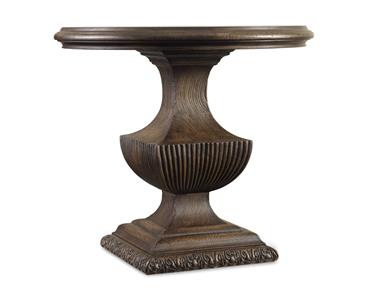
Hooker Furniture Bedroom Rhapsody Urn Pedestal Nightstand 5070-90015 comes with classic designs and a rustic finish.
Gable roofs are also common which give the homes their gingerbread appeal. Modern-day Tudor replicates the genuine Tudor Dynasty through architecture and interior design revivals. If you haven’t yet, you should install tall, narrow windows with small panes. Modern day cladding is acceptable such as flagstone, brick and stucco.
As for the outdoor landscaping, be sure to have manicured hedges, brick walkways, fencing and pool houses. These amenities should set you apart from the neighbors but in a nice way.
The Old World style can also be brought inside the kitchen through wrought iron and wood combinations in furniture pieces. Custom islands and wrought-iron lighting fixtures are also a huge part of Tudor interiors.
Are you ready to take on Tudor design, a unique style right inside your home?
Tags: 16th century, classic, classic design, classic home, classic interior design, classic interiors, classic style, classical design, designing based on culture, designing with glass, European interior design, European interiors, European style, fireplace, glamour, glass, glazing, Italian style, McCreerys, McCreerys Home Furnishings, old home, old homes, revival, symmetry, traditional, traditional interior design, traditional interiors, traditional style, traditional theme, Tudor, Tudor architecture, Tudor design, Tudor furniture, Tudor interior design, Tudor interiors, vaulted ceiling, Victorian, Victorian interiors, Victorian style
Posted in Interior Design 101, Interior Design Elements, Interior Design Themes | No Comments »
Monday, January 25th, 2016
If your heart jumps each time you see a condominium unit or a townhouse, then know that you have to prepare to live in a place that is cozy. Foregoing the idea of an open space plan is not an easy decision to make but should you sign up for this kind of home, then it’s time to look for the right design that is most suitable for it. ‘Ever considered the shabby chic style?
Okay, so you have saved every bit of hard-earned money and have sacrificed on shopping and travel – what now?
Old vs. New
Carefully plan what theme you will use before you move in to your new condominium or townhouse unit. One of the most utilized, these days, when it comes to limited space is the shabby chic concept.
Rachel Ashwell popularized this stylish interior design concept to focus on comfort, highlight the beauty of seemingly time-worn furniture and objects, and for the homeowner to appreciate practical living.
This concept can even guide you in mixing traditional and new pieces. Choose from our catalogue and find the right furniture, accessories and lighting fixtures.
If you are thinking of buying second-hand furniture, think again. It is much better to have new furniture given a distressed appeal than to take the risk of buying the damaged ones. Bargain shops sell at the lowest prices but you are never guaranteed of the quality of the stuff that you are buying. So, it is much better to invest in a few quality pieces than to have different sets of furniture only to end up spending more money on repairs.
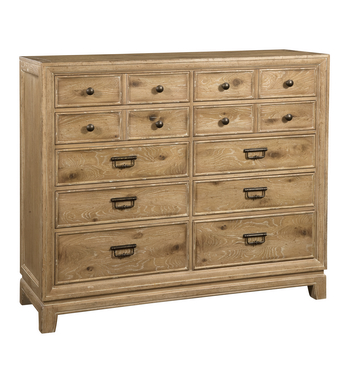
Coming from the Ancestry Collection of FFDM, this light-colored drawer is sure to be a big hit inside any shabby chic setting.
Let’s Decorate
The shabby chic style is basically minimalist and is almost synonymous with white. You may paint the walls of your home with flat white, pearl, cream, or any shade of white. Apart from having white(ish) walls, take note that you also need to have a few white furniture and accent pieces. These will add a distinct as well as intimate feel to your home. White furnishings are also easy to clean using your regular household bleach.
Now, which room would you like to design first?
First, there’s the living room. Carry the modern facade from the outside to this part of your home. Your condominium or townhouse unit will surely have a rustic yet cozy appeal once you start bringing in the lovely furniture and accent pieces.
The living room must have a clean yet non-antiseptic feel. It should be minimalist but with a few accent pieces to boost such as a lovely chest, a coffee table, console table, or some shelves.
In the dining room, be sure to showcase a table that was aged to sit perfectly in this important space. Have a Victorian couch rest against the white wall. Wicker chairs would look lovely when placed with white curtains as backdrop.
Now to the kitchen: have the furniture and appliances in neutral colors. This is so they won’t clash with the condo or townhouse’s overall appeal.
If you are one of those who prefer to have a home office, then use a white desk as much as you can. Now couple the lovely white desk with a unique accent chair and some neutral shelves.
Should you still have space for one guest room, then make sure that this room is just as cozy as the rest of your home. Use the same shade on the walls and on the furniture that will be placed there. Since the bed is pretty much the focal point, then take time to choose the ones that you will invest in for the master bedroom as well as this room.
Lastly, with your shabby chic bathroom, ascertain that you do not miss out on an ornate mirror that will bring character to this room. Find one that has a wooden frame that matches the stylish theme that you have chosen.
Tags: classic, classic design, classic home, classic interiors, classic style, feminine, feminine design, feminine interior design, feminine interiors, feminine style, McCreerys, McCreerys Home Furnishings, minimalist, minimalist design, old, old vs. new, rustic, rustic charm, rustic design, rustic elements, rustic home, rustic interior design, rustic interiors, rustic look, rustic style, rustic theme, shabby chic, shabby chic design, shabby chic interior design, shabby chic interiors, timeless, timeless design, timeless interior design, timeless interiors, tips, white, white color palette, white color scheme, white furnishings, wood, wood elements, wood furniture pieces, wooden elements, wooden furniture
Posted in Interior Design 101, Interior Design Elements, Interior Design Themes, Interior Design Trends | No Comments »
Wednesday, January 20th, 2016
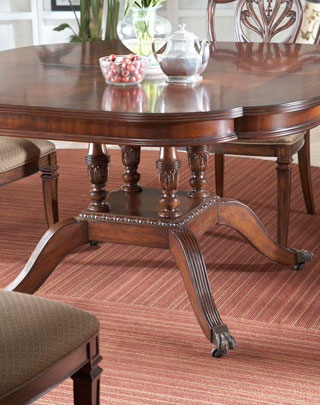
What would be more perfect for the dining room in your old home than this table from the Antebellum Collection of FFDM?
Do you know the old saying that old homes have souls? If this is the case, then you really have to find time to redesign an old home (if you happen to live in one). Interior design, after all, is not all about the creation of a new residence. If you are one of the few that are blessed to own a house that has already earned its own character, then it’s high time to bring out its best features.
Hide All Imperfections
One of the best ways to conceal imperfections is to paint over them. So go ahead and paint the ceilings and walls. Be sure to highlight the walls, trim and ceiling.
What makes people fall in love with older homes is how they speak of a different era. Back then, there was a certain level of personality and polish that are required for finishing touches. Simple coats of paint can preserve and highlight beautiful architectural details.
Designers typically paint a single color on the trim, walls and ceiling. The trim has a slightly higher gloss so that it subtly calls for attention. Once this palette is already in place, find a bold shade such as dark gray to paint your doors. These will serve as architectural highlights in your home.
Paint the trim work in neutral contrasting shade if it is still in great shape. This is a great way to show it off while being consistent in every room throughout your place. Applying the same paint on the ceiling can help fuse the look together for a more stately and architectural appeal.

Hooker Furniture Bedroom True Vintage Arched Mirror comes in a light wood finish and an elegantly aged driftwood finish.
Still on your home’s vintage trim, make sure to use in-window shade rather than hanging drapes. This is so you can leave the trim exposed for everyone to enjoy. These shades also add a modern touch in a subtle way, one that would not steal the integrity of your original home.
If, however, you have awkward looking windows, then go ahead and use those drapes. A lot of older homes tend to have quirky windows. A wall of drapery should hide such windows.
Another beauty that you can use in designing old homes is the installation of stained glass. If you do not already have them, invest in this type of glass which will make simple white walls appear more stimulating.
Embrace Contemporary Furnishing
If you want your traditional home to have an edgy, modern-day feel, then make sure that you invest in contemporary furniture pieces. These are those simple pieces with clean lines. Find rich textures, soft colors and linear pieces. Going radical when it comes to modernity is not the way to go, though. Make sure that you are able to control both contemporary and traditional concepts in such a way that they won’t fight. Take for instance the lovely Universal Furniture Bedroom Santa Rosa Poster Bed (313280B) which brings together both contemporary and traditional concepts so beautifully. This queen size bed is crafted using birch veneers and hardwood. It comes in two-tone finish namely the dark vintage and the lighter heirloom tone. Its aged birch veneer is the right touch to any traditional setting. Add to this the antiqued metal, crown molding, as well as overhanging tops, and you’ve achieved sophistication.
This lovely bed also comes in California king size.
Still on mixing modern and traditional periods, another way to add a modern feel is to place appliances such as TV, a computer or a plush sofa inside the room. Modern accessories will also make a huge difference in old homes so don’t be afraid to add in a dash of modernity.
Tags: classic, classic design, classic home, classic interior design, classic interiors, classic style, classicism, contemporary, drapes, guidelines, McCreerys, McCreerys Home Furnishings, modern, neutral paint, neutral paint colors, old architecture, old home, old homes, redesigning old homes, timeless, timeless design, timeless interior design, timeless interiors, tips
Posted in Architectural Elements, Interior Design 101, Interior Design Themes | No Comments »
Wednesday, January 13th, 2016
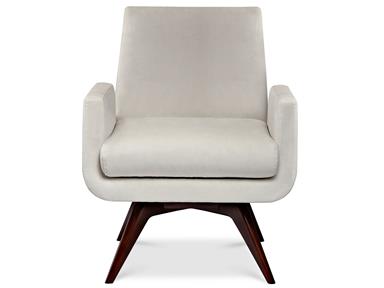
American Leather Living Room Chair MSL-CHS-ST is perfect for any Mid-Century interior because of its clean lines and natural hue. John Mascheroni designed this beautiful piece giving emphasis to mid-century modern streamlined edges fused with a wooden cross base.
If you are trying to achieve the mid-century interior design in your home, then it is best to understand what aspects to mix.
Furniture to be used under this category is characterized by simple, clean lines. Teak and other wood pieces are most welcome. Find mid-century tables and pair them with contemporary chairs. Have teal walls as bold backdrop and you have just attained the epitome of this design.
Never make the mistake of hiding wood details, instead, allow them to shine. Neutral-colored walls will look great with fabrics in soft hues. Find handcrafted furniture and accessories to complete the living room mid-century look.
Mid-Century Is Timeless
McCreery’s Home Furnishings provides furniture pieces that have been thoughtfully crafted by master artisans, hence, they are the perfect classic pieces if you are looking into creating the mid-century habitat.
Table lamps are the right lighting pieces for that low-slung furniture. The curvy base of the Maitland Maitland-Smith Lamps and Lighting Table Lamp 1700-427 will look great in a vintage-looking nightstand.

Maitland-Smith Lamps and Lighting Table Lamp 1700-427 is a spell-binding addition to your living room or bedroom.
Natural lighting can also bathe your black and white-themed living room. Draw back any curtains to let in the sunlight. The black and white color scheme is best for the mid-century style as it keeps the areas looking clutter-free. This is achieved by highlighting space and light.
After considering lighting, it’s time to turn your attention to focal points. Retro lighting can be an effective focal point. Chandeliers can easily stand out against pinstripe walls. Take the retro vibe up another notch by also adding vintage art pieces. Search for striking wall hangings inspired by circles and squares.
Since mid-century spells timelessness, the use of vintage colors is also encouraged. It’s time to start loving avocado hues, also mustard, tangerine and other ‘60s colors. Just be careful in your use of these colors or your place would come across as a movie set.
For more ‘60s inspired pieces, decorate with a coffee table with a hint of gold. Add glass or sculptural accents, these will pop against white walls.
Mid-century also means showcasing superior pieces so, it is best to paint the walls white or any neutral palette. The rich, graphic patterns may appear on upholstered furniture pieces, throws, or on the textured wallpapers.
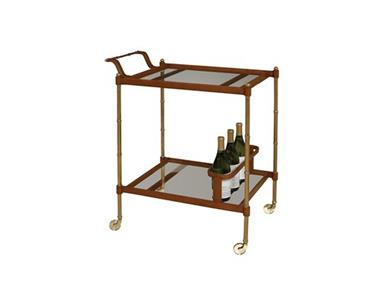
The Maitland-Smith Accessories Bamboo Cast Brass Bar Cart 3020-042 can carry your vintage glassware and cocktail shakers.
Emphasize the cocktail culture by making use of a bar cart while the rest of the room features streamlined seats and traditional lamps. If you are more traditional, then use a glass and bronze coffee table.
For those who embrace the contemporary culture more than retro, it is acceptable to have at least one mid-century piece to add warmth to the environment. For instance, the marriage of red and white inside a living room can have wood and glass table as a focal point.
Would you want to have contrasting seat cushions? Add these to a wood swivel and you can spice up your mid-century home office.
Mid-century interior design and modern styles, as opposed to common notion, can actually mix. The super clean lines of both styles can be the chief characteristics of mid-century modern furnishings. This is the right combination for those stark industrial pieces. This is the ideal style pairing for those people who prefer urban loft living.
Tags: 1960s, accent pieces, classic, classic design, classic home, classic interior design, classic interiors, classic style, classicism, guidelines, lamp, McCreerys, McCreerys Home Furnishings, mid-century interior design, mid-century interiors, mid-century style, retro, timeless, tips, vintage, vintage design, vintage furniture, vintage interior design, vintage interiors
Posted in Interior Design 101, Interior Design Elements, Interior Design Themes | No Comments »
© McCreery's Home Furnishings | All Rights Reserved | Privacy Policy